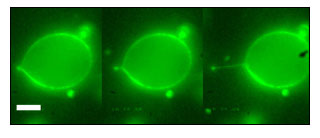GAITHERSBURG, Md., Feb. 3, 2006 -- Scientists at the National Institute of Standards and Technology (NIST) have created unusually long polymer nanotubes that could one day be used as incredibly tiny hypodermic needles, capable of injecting molecules one at a time.
Carbon nanotubes are of keen interest in nanotechnology research, especially for making ultrastrong fibers and other structures. Nanotubes made from other materials are used for transport in biochemical applications, but are typically fragile and usually collapse within a few hours. The NIST team developed processes for extending the shelf life of polymer nanotubes —- considered essential for commercial applications —- and forming sturdy nanotube network structures.

This sequence of images taken at NIST shows the creation of a nanotube as a highly focused infrared laser tugs on a polymer membrane that has been colored with a fluorescent dye. The white scale bar indicates 10 µm. (Images: NIST)
These nanotubes are unusually long (about 1 cm) as well as stable enough to maintain their shape indefinitely. The scientists say they may have biotechnology applications as channels for tiny volumes of chemicals in nanofluidic reactor devices, for example, or as hypodermic needles for injecting single molecules.
To create the nanotubes, first the researchers made tiny, fluid-filled spherical containers with bilayer membranes consisting of polymers with one end that likes water and one end that does not. (These fluid-filled containers are a spin-off of liposomes, artificial cells with fatty membranes used in cosmetics and for drug delivery.) The researchers made the membranes stretchy by adding a soap-like fluid to change the polymer membranes’ mechanical properties. They then used highly focused infrared lasers as “optical tweezers” or tiny droppers called micropipettes to pull on the elastic membranes to form long, double-walled tubes that are less than 100 nm in diameter.
A chemical was added to break bonds between atoms in one section of the polymers and induce new bonds to form between the two different sections, forming a rigid cross-linked membrane. The nanotubes are then snipped free from the parent cell with an “optical scalpel,” or highly focused ultraviolet laser pulse. The nanotubes maintain their shape even after several weeks of storage, and can be removed from the liquid solution and placed on a dry surface or in a different container. The optical tweezers can be used to custom-build nanotube network structures.
Described in a recent paper by Joseph E. Reiner, Jeffrey M. Wells, Rani B. Kishore, Candace Pfefferkorn and Kristian Helmerson in Proceedings of the National Academy of Sciences, the NIST work was supported in part by the Office of Naval Research. For more information, visit: www.nist.gov